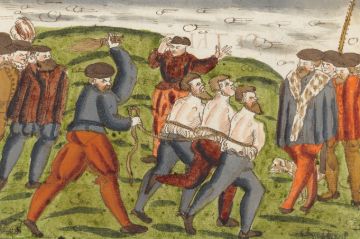Main board: Schimpf und Schande - Maligned and Disgraced
The convictions of Anabaptists were tolerated neither by the church nor by the state. Rulers in Europe and churches, sometimes hand in hand, fought Anabaptism for centuries and treated it with “shame and disgrace”.
In what is now Switzerland, it was Bern that persecuted the Anabaptists particularly long and intensely. Although some urged moderation here as well, the hardliners were usually stronger. The Anabaptist mandates of the 16th to 18th centuries paint a picture of the measures:

The three Anabaptists Heinrich Pfister, Ueli Läderach and Hans Stähli are driven out of the city of Bern with a broom in 1585 (Zentralbibliothek Zürich, Ms F 33, p. 185).
Anabaptists were tracked down by checking their participation in church activities, military inspections and oaths. Anabaptist homes were checked to see what books were available. If someone betrayed his Anabaptist neighbors, he was rewarded. Shady hunters were on the road as "Anabaptist hunters" to find suspects for a fee, arrest them and hand them over to the court.
Whoever was caught as an Anabaptist had to expect drastic punishments: One was thrown into prison, expropriated or had to pay high fines. Torture, flogging and "drawing" with a branding iron were often added. Many were expelled or deported forever. Those who were sent to the galleys usually never returned. Executions - 40 people alone by 1571 - also got rid of the "heretics".
Further measures were taken to prevent people from converting to Anabaptism in the first place: New parishes were created in Anabaptist areas, for example in Eggiwil, Schwarzenegg and Heimiswil; in this way, church attendance and baptism could be better controlled. Contact with Anabaptists through trade, harboring and even sympathizing could have serious consequences.



